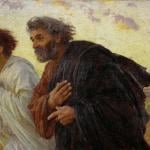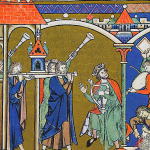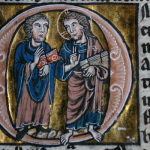Last updated on: April 2, 2015 at 1:54 pm
By
CNA Daily News
Washington D.C., Apr 2, 2015 / 07:54 am (CNA).- As Catholics around the globe prepare for the Easter Triduum, the three-day period beginning with Holy Thursday and culminating in the celebration of Easter, the Jewish community prepares for its own liturgical celebration of Passover, remembering how God freed their ancestors from slavery in Egypt. These two liturgical events are connected, and Catholics of Jewish origin stress that recognizing this connection can help give context and deepen the understanding of Christ’s Paschal sacrifice and the ultimate meaning of Easter. Roy Schoeman, an author and self-described “Hebrew Catholic” – or Catholic of Jewish heritage – spoke to CNA about the inseparable link between Christ’s Passion and the whole of salvation history. “Judaism and the Catholic Church are not two different religions,” but instead form “one tapestry of salvation,” reaching “from the Garden of Eden until the Second Coming,” and in which Abraham and the other Hebrew fathers play a significant role, he explained. “They are one system of salvation that God set up at the beginning of time for all mankind, divided into two phases, the preparatory phase, which is to prepare for the incarnation of God as man, and the fulfillment phase, a second period of salvation history, in between God’s incarnation as man and His second coming.” The covenant, or promise, God formed with Abraham to send a Messiah and set aside the Jewish people is a prefigurement of the sacrifice of Jesus and salvation of all peoples, Schoeman explained. God’s testing of Abraham, asking him to sacrifice his son Isaac, is a clear image of this foreshadowing of Christ’s sacrifice at Calvary, he continued. “Basically, as Abraham put the wood forth for his son’s sacrifice on his shoulders, led him up the mountain, bound him on the wood and was about to sacrifice him, was a precursor to the fulfillment of that picture.” That fulfillment, “is God taking his own beloved son, putting the wood on His shoulders, leading Him up literally to the very same mountain, binding him to the wood, that is nailing him to the Cross, and truly sacrificing.” “All of Passover was a prefigurement of the Crucifixion,” Schoeman continued. “The Exodus from Egypt in Jewish theology was always seen as a prefigurement of the coming of the Messiah in Jewish theology. The Passover Seder is full of explicit Messianic references, including the place setting for Elijah,” he said of the ceremonial Passover meal. For instance, throughout the Gospel narrative of the Last Supper and Crucifixion, “Jesus is explicitly equated with the Paschal lamb,” Schoeman commented. This is seen in the fulfillment of requirements such as “not a bone of the Passover lamb must be broken,” when Christ’s legs were not broken on the Cross. The use of unleavened bread for the Eucharist in the Roman Catholic Church is another sign of the link between the promises God made to the Jewish people and the fulfillment in Christ’s sacrifice. This recognition is part of Church history – many writings of the early Church Fathers, Schoeman noted, likened “the Jews’ slavery to the Pharaoh in Egypt was a picture of mankind’s slavery to sin,” and drew other parallels between the Jewish people and the Universal Church. Fr. Paul Schenck, a Catholic priest raised in the Jewish faith before becoming first a Protestant pastor and then being received fully into the Church, also spoke of the powerful lived experience and significance of the Eucharist, as well as its prefigurement in Passover. “The Eucharist itself as an action, as a sacrifice, as a liturgy, arises out of the Passover,” he explained to CNA. “These are interlocked eternally.” He noted the Last Supper and the institution of the Eucharist took place during the ritual Passover meal. “Out of this liturgy of the Exodus arises the Liturgy of the Eucharist, so it behooves us to understand the entity which is the blueprint, the framework of what we do.” Both the Passover and the Eucharist share a unique view of ritual remembrance that involve a real presence and participation in the event remembered, he said. “We know the story of the first Passover is the story of the liberation of the people of Israel from their slavery in Egypt. But it’s more than that, it’s a timeless event.” Recalling one of his earliest memories of Passover as a young boy, Fr. Schenck commented particularly on the part of the meal where they were told, “Tonight we are slaves in Egypt.” This remembrance impacted him greatly: “I was no longer a kid in the suburbs of New York, I was a slave in Egypt,” he recounted. “Passover is a timeless event, and there’s a reason for that,” he continued. “Passover illustrates the greatest sacrifice ever made in the history of the universe – the Passover of the Son of God, the Savior, who becomes the Lamb of God and takes away the sins of the world.” It is this sacrifice, he said, that is remembered at every Mass. “I always remind Catholics, we celebrate the Passover at every Eucharist. We are perpetuating the feast.” During the celebration of the Mass, many of the prayers and the words of consecration during the liturgy come from “the very same prayer that we say at the Passover Seder.” For Fr. Schenck, this link makes a profound impact on his celebration of the Eucharist. “As a priest there’s simply no more transcendent, marvelous, wondrous moment than when I have the great and utterly undeserved privilege of reciting those words at the altar over the bread and the wine, and then after to elevate the host.” However, perhaps most striking for Fr. Schenck is the importance Jesus attributes to the Last Supper, his final Passover meal before his death. Jesus said in the Gospel of Luke that He “desired with great desire to celebrate the Passover” with his disciples. “That immediately tells us that this is an unavoidable, inescapable central element of our faith as Christians, as Catholics, as people of the Eucharist.” For Catholics who wish to learn more about these roots at the base of Holy Week, Fr. Schenck suggested participating in a Passover Seder dinner, but cautioned Catholics to heed the bishops’ guidelines for participation. The U.S. bishops’ 1998 document, “God's Mercy Endures Forever: Guidelines on the Presentation of Jews and Judaism in Catholic Preaching,” acknowledges “educational and spiritual value” in participating in Seders, but warned against merging the liturgical rubrics of the Seder – called a Haggadah – with New Testament readings or with the Eucharist. “Such mergings distort both traditions,” they cautioned, adding that the “primary reason why Christians may celebrate the festival of Passover should be to acknowledge common roots in the history of salvation,” and such celebrations are not a “restaging” of the Last Supper or alternative to the Triduum. “When we celebrate the Passover it should be with an authentic Haggadah and it should be in unity with the Jewish people, not use it ever as a polemic,” Fr. Schenck warned. Schulman echoed the call for learning and education, citing books and talks by scholars like Scott Hahn and Brant Pitre as useful resources for learning about the roots underneath the celebrations of Holy Week. Regardless of background, Schoeman suggested, Catholics should learn about the history of the Jewish people, because it contains “the whole root and trunk of this story of the Last Supper, the Mass and the act of redemption.” “It’s the flowering of the tree of Judaism. If you just cut off the top slice of the tree, you’re not seeing much.” Read more















